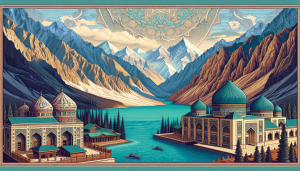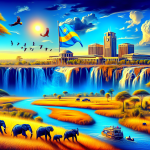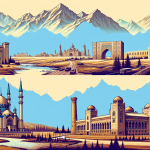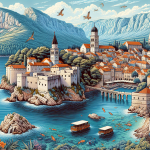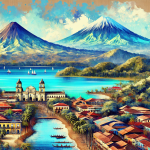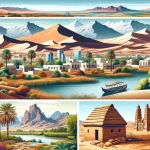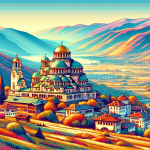Exploring the Hidden Gems of Tajikistan: A Comprehensive Travel Guide
Tajikistan, a landlocked country nestled in Central Asia, remains one of the world’s most enigmatic and untouched travel destinations. With its stunning mountainous landscapes, rich cultural heritage, and warm-hearted locals, Tajikistan offers an unforgettable experience for intrepid travelers. Despite its relatively obscure status on the global tourism map, this country is brimming with natural wonders and historical sites that captivate the imagination. From the majestic Pamir Mountains to the ancient Silk Road cities, Tajikistan presents a unique blend of adventure and tradition. In this comprehensive travel guide, we will delve into the must-visit attractions, practical travel tips, and cultural insights to make your journey through Tajikistan an extraordinary one.
Discovering Tajikistan’s Majestic Landscapes
The Pamir Mountains
The Pamir Mountains, often referred to as the “Roof of the World,” are the crown jewel of Tajikistan’s natural scenery. These towering peaks, some exceeding 7,000 meters, offer a paradise for trekkers and mountaineers. The Pamir Highway, one of the world’s highest-altitude roads, snakes through this rugged terrain, providing breathtaking vistas at every turn. Travelers can explore remote villages, pristine lakes, and dramatic valleys, immersing themselves in the raw beauty of nature. The Wakhan Corridor, a narrow strip of land along the Afghan border, is another highlight, offering panoramic views of the Hindu Kush and the Wakhan River.
Iskanderkul Lake
Named after Alexander the Great, Iskanderkul Lake is a serene alpine lake surrounded by lush forests and towering mountains. Located in the Fann Mountains, this turquoise gem is an ideal spot for hiking, birdwatching, and picnicking. The nearby Iskanderkul Waterfall, also known as “Fann Niagara,” is a spectacular sight that should not be missed. The area is also rich in flora and fauna, making it a haven for nature enthusiasts.
The Fann Mountains
The Fann Mountains are another trekking paradise in Tajikistan, offering a network of trails that traverse through alpine meadows, crystal-clear lakes, and rugged peaks. The Seven Lakes (Haft Kul) are a series of seven stunning lakes, each with its unique color and charm. These lakes are accessible via a challenging yet rewarding trek, providing an immersive experience in the heart of nature. The region is also dotted with traditional mountain villages, where travelers can experience the local way of life and hospitality.
Cultural Heritage and Historical Sites
Dushanbe: The Capital City
Dushanbe, the capital of Tajikistan, is a vibrant city that seamlessly blends modernity with tradition. The city’s name means “Monday” in Persian, reflecting its origins as a market town where traders gathered on Mondays. Today, Dushanbe boasts a mix of Soviet-era architecture, bustling bazaars, and contemporary developments. Rudaki Park, named after the famous Persian poet, is a popular spot for leisurely strolls and picnics. The National Museum of Tajikistan offers a fascinating insight into the country’s history, culture, and art. The city’s main landmark, the Tajikistan National Library, is one of the largest in Central Asia and a must-visit for book lovers.
Khujand: An Ancient Silk Road City
Located in the northern part of the country, Khujand is one of Tajikistan’s oldest cities and a significant stop along the ancient Silk Road. The Khujand Fortress, dating back to the 7th century, stands as a testament to the city’s historical importance. The nearby Panjshanbe Bazaar, one of Central Asia’s largest and oldest markets, offers a vibrant atmosphere where visitors can shop for local handicrafts, spices, and fresh produce. The Sheikh Massal ad-Din Complex, an architectural marvel, is another highlight that showcases the region’s rich Islamic heritage.
Penjikent: The Ruins of an Ancient Civilization
Penjikent, located in the Sughd region, is an archaeological treasure trove that offers a glimpse into the ancient Sogdian civilization. The Ruins of Ancient Penjikent date back to the 5th century and feature remnants of a once-thriving city, including residential quarters, temples, and fortifications. The nearby Sarazm, a UNESCO World Heritage site, is an even older settlement that dates back to the 4th millennium BCE. These historical sites provide a fascinating insight into the region’s early history and cultural evolution.
Practical Travel Tips for Tajikistan
Visa and Entry Requirements
Travelers to Tajikistan need to obtain a visa before arrival. The e-Visa system makes the process relatively straightforward, allowing travelers to apply online and receive their visa electronically. It’s important to check the latest visa requirements and regulations before planning your trip, as these can change frequently.
Currency and Budgeting
The local currency in Tajikistan is the Tajikistani Somoni (TJS). While major cities like Dushanbe have ATMs and currency exchange facilities, it’s advisable to carry cash when traveling to remote areas. Tajikistan is an affordable destination, with budget-friendly accommodation, food, and transportation options. However, it’s always wise to have some extra funds for unexpected expenses.
Language and Communication
Tajik, a variant of Persian, is the official language of Tajikistan. Russian is also widely spoken, especially in urban areas. English is not commonly spoken, so it’s helpful to learn a few basic phrases in Tajik or Russian to facilitate communication. Carrying a translation app or phrasebook can also be useful.
Health and Safety
Tajikistan is generally a safe country for travelers, but it’s essential to take standard precautions. Avoid drinking tap water and opt for bottled or boiled water instead. Make sure to have comprehensive travel insurance that covers medical emergencies and evacuation, as healthcare facilities in remote areas may be limited. It’s also recommended to check for any travel advisories and health recommendations before your trip.
Embracing Tajikistan’s Unique Culture
Local Cuisine
Tajik cuisine is a delightful blend of Persian, Russian, and Central Asian influences. Plov, a hearty rice dish with meat and vegetables, is a national favorite. Samsa, savory pastries filled with meat or vegetables, are popular street food snacks. Laghman, a noodle soup with vegetables and meat, is another must-try dish. Fresh fruits, nuts, and dairy products also feature prominently in the local diet. Sharing a meal with a Tajik family is a wonderful way to experience the country’s hospitality and culinary traditions.
Traditional Music and Dance
Music and dance are integral parts of Tajik culture, reflecting the country’s rich heritage and diverse influences. The Rubab, a traditional string instrument, is often used in folk music performances. Falak, a genre of traditional Tajik music, features melancholic melodies and poetic lyrics. At the same time, the Lazgi dance is a lively and energetic performance that showcases the region’s vibrant spirit. Attending a cultural show or festival is a fantastic way to immerse yourself in Tajikistan’s artistic traditions.
Festivals and Celebrations
Tajikistan’s calendar is filled with colorful festivals and celebrations that highlight the country’s cultural diversity. Navruz, the Persian New Year, is one of the most important and widely celebrated events in Tajikistan. It marks the arrival of spring and is characterized by feasting, music, dance, and various traditional rituals. The Independence Day celebrations on September 9th are another significant event, featuring parades, concerts, and fireworks. Participating in these festivities offers a deeper understanding of Tajikistan’s cultural heritage and national pride.
Adventure Activities in Tajikistan
Trekking and Hiking
Tajikistan’s rugged terrain and pristine landscapes make it a paradise for trekking and hiking enthusiasts. The Fann Mountains and the Pamir Mountains offer a range of trails that cater to different levels of experience and fitness. Whether you’re embarking on a multi-day trek through remote valleys or a day hike to a picturesque lake, the country’s natural beauty will leave you in awe. Hiring a local guide can enhance your trekking experience by providing valuable insights into the region’s geography and culture.
Cycling and Biking
For those who prefer exploring on two wheels, Tajikistan’s scenic routes offer exhilarating cycling and biking opportunities. The Pamir Highway, with its dramatic landscapes and challenging terrain, is a bucket-list destination for avid cyclists. The route takes you through high mountain passes, remote villages, and stunning valleys, providing a sense of adventure and accomplishment. Ensure you’re well-prepared with the right gear and equipment, as services and facilities along the way can be limited.
Rafting and Water Sports
Tajikistan’s rivers and lakes provide ample opportunities for water-based adventure activities. The Bartang River and the Panj River are popular spots for white-water rafting, offering thrilling rapids and breathtaking scenery. Kayaking, fishing, and swimming in the country’s pristine lakes and rivers are also enjoyable experiences for water sports enthusiasts. Always prioritize safety and consider hiring professional guides for these activities.
Sustainable Travel and Responsible Tourism in Tajikistan
Supporting Local Communities
Traveling responsibly in Tajikistan involves supporting local communities and businesses. Opt for locally-owned accommodations, restaurants, and tour operators to ensure that your spending benefits the local economy. Participating in community-based tourism initiatives, such as homestays and cultural tours, provides authentic experiences while contributing to the well-being of the host communities. Engaging with local artisans and purchasing handmade crafts also helps preserve traditional skills and cultural heritage.
Minimizing Environmental Impact
Tajikistan’s pristine natural environments are a precious resource that requires protection. As a responsible traveler, take steps to minimize your environmental impact. Practice Leave No Trace principles by disposing of waste properly, avoiding single-use plastics, and respecting wildlife and natural habitats. Consider using eco-friendly products and transportation options whenever possible. By making conscious choices, you can help preserve Tajikistan’s natural beauty for future generations.
Respecting Local Customs and Traditions
Respecting local customs and traditions is essential for fostering positive interactions and cultural exchange. Dress modestly, especially in rural areas and religious sites, to show respect for local norms. Seek permission before taking photographs of people, and be mindful of cultural sensitivities. Learning a few basic phrases in Tajik or Russian can go a long way in building rapport with locals and demonstrating your appreciation for their culture.
Conclusion
Tajikistan is a captivating destination that offers a unique blend of natural beauty, cultural richness, and adventurous experiences. From the majestic Pamir Mountains and serene alpine lakes to the ancient Silk Road cities and vibrant festivals, this Central Asian gem has something for every traveler. By embracing sustainable travel practices and respecting local customs, you can embark on a memorable journey that leaves a positive impact on the people and places you encounter. Whether you’re seeking adventure, cultural immersion, or simply a break from the ordinary, Tajikistan promises an unforgettable travel experience that will stay with you long after you’ve returned home.
For more in-depth travel guides and expert tips, visit Lonely Planet, your go-to resource for exploring the world’s most fascinating destinations.
